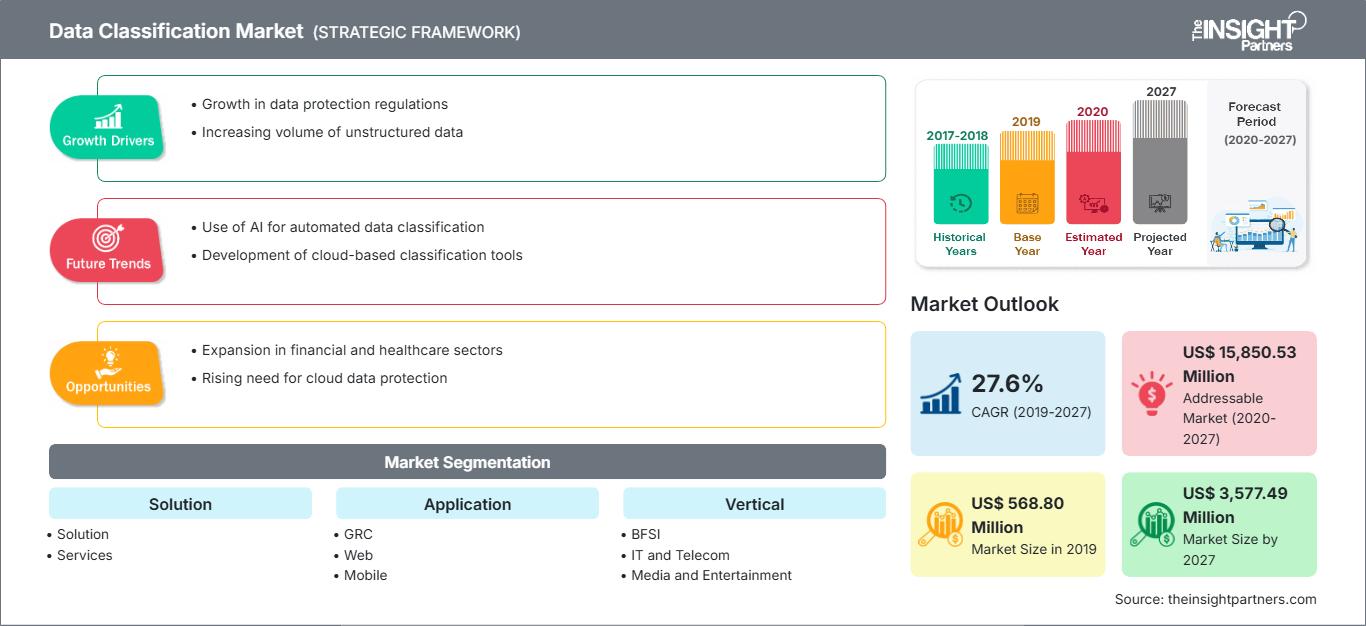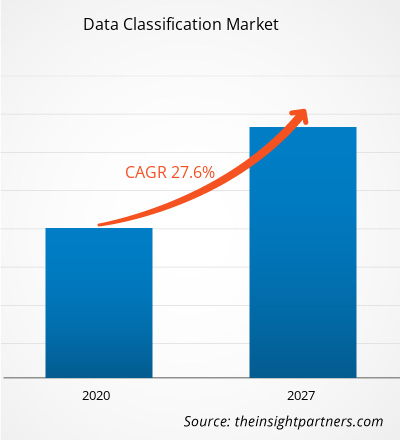2019 年数据分类市场价值为 5.688 亿美元,预计到 2027 年将达到 35.7749 亿美元。预计 2020 年至 2027 年数据分类市场的复合年增长率为 27.6%。
数据分类是一种将海量数据分类到不同选项卡中的工具,可在保护机密数据隐私的同时最大限度地利用数据。GDPR 和健康保险流通与责任法案 (HIPAA) 等数据保护法的商业化与影响全球数据分类的范围直接相关。不断增长的业务数据和云迁移、个人数据识别的增加、电子邮件中的隐私威胁、机器学习的利用以及数据管理和数据保护的融合都是在加速数据分类范围方面发挥重要作用的因素。数据分类在全球范围内发展势头强劲。推出数据分类工具以应对网络威胁正在为市场增长铺平道路。此外,英国、美国、德国和新加坡等国政府部门日益重视数据保护法,这也推动了数据分类的采用率。此外,将机器学习和人工智能等先进技术集成到数据分类工具中,可以加速整个企业的产出和生产力。例如,40% 的美国公司使用机器学习来改进其销售和营销策略,而欧洲银行也见证了机器学习的应用,其产品销售额增长了 10%,客户流失率降低了 20%。
数据分类市场细分为组件、应用程序、垂直行业和地域。基于组件,解决方案细分市场占据了全球数据分类市场的最大份额。数据分类解决方案衍生出应用于特定数据集的安全控制措施。基于应用程序,Web、移动和电子邮件保护细分市场在 2019 年占据了全球数据分类市场的主导地位。随着企业和行业之间使用电子邮件、移动和 Web 应用程序传输数据的现象日益增多,数据保护和数据分类工具已成为必需品。从垂直行业来看,BFSI 细分市场在 2019 年贡献了相当大的份额,预计在预测期内将继续保持主导地位。从地理上看,市场分为五大区域——北美、欧洲、亚太地区 (APAC)、中东和非洲 (MEA) 以及南美 (SAM)。
自定义此报告以满足您的要求
您将免费获得任何报告的定制,包括本报告的部分内容,或国家级分析、Excel 数据包,以及为初创企业和大学提供超值优惠和折扣
数据分类市场: 战略洞察

-
获取本报告的主要市场趋势。这个免费样本将包括数据分析,从市场趋势到估计和预测。
美国、德国、英国和新加坡等国的政府都已出台数据加密和保护法来监管 IT 公司,因此科技公司正在这些市场中寻找机会推广其数据分类服务。美国和英国政府为公共部门制定了三级数据分类方案。就连华盛顿州政府也超越了这一范围,建立了五级分类方案,并因其为该领域的行业供应商创造了潜在空间而受到该地区开放数据倡导者的高度赞扬。保险公司和银行等各种金融服务公司是数据分类解决方案的主要用户,因为他们必须处理大量的个人身份信息 (PII) 并遵守政府数据保护法规。
基于组件的市场洞察
基于组件,数据分类市场细分为解决方案和服务。 Titus、Boldon James、Digital Guardian、Spirion 和 Netwrix 是市场上一些知名的参与者,他们满足数据保护和数据分类的需求。这些公司提供完整的数据分类工具和一系列服务,以确保解决方案的正常运行。
基于应用的市场洞察
根据应用,数据分类市场细分为治理、风险与合规、Web、移动和电子邮件保护等。
基于垂直行业的市场洞察
根据垂直行业,数据分类市场细分为:BFSI、IT 和电信、媒体和娱乐、零售、教育、医疗保健等。银行和其他各种金融行业公司使用机器学习 (ML) 技术来实现两个基本目的:识别有价值的数据洞察和防止欺诈。这些洞察可以识别投资机会或帮助投资者了解何时进行交易。
在数据分类市场运营的参与者专注于市场计划、收购和产品发布等策略,以保持其在数据分类市场中的地位。数据分类市场主要参与者的一些进展如下:
2020年3月,Netwrix 允许信息安全和治理专业人员检索机密、受监管和业务关键数据的控制权。该公司推出了 Netwrix Data Classification 5.5.2。
2018年11月,数据保护解决方案领导者 Titus 推出了 Titus Intelligent Protection。这款新工具提供由分类驱动的机器学习,以降低数据丢失的风险。
数据分类市场区域洞察
The Insight Partners 的分析师已详尽阐述了预测期内影响数据分类市场的区域趋势和因素。本节还讨论了北美、欧洲、亚太地区、中东和非洲以及南美和中美洲的数据分类市场细分和地域分布。
数据分类市场报告范围
| 报告属性 | 细节 |
|---|---|
| 市场规模 2019 | US$ 568.80 Million |
| 市场规模 2027 | US$ 3,577.49 Million |
| 全球复合年增长率 (2019 - 2027) | 27.6% |
| 历史数据 | 2017-2018 |
| 预测期 | 2020-2027 |
| 涵盖的领域 |
By 解决方案
|
| 覆盖地区和国家 |
北美
|
| 市场领导者和主要公司简介 |
|
数据分类市场参与者密度:了解其对业务动态的影响
数据分类市场正在快速增长,这得益于终端用户需求的不断增长,而这些需求的驱动因素包括消费者偏好的演变、技术进步以及对产品优势的认知度的提升。随着需求的增长,企业正在扩展其产品线,不断创新以满足消费者需求,并利用新兴趋势,从而进一步推动市场增长。

- 获取 数据分类市场 主要参与者概述
- 解决方案
- 服务
数据分类市场 — 按应用划分
- GRC
- Web
- 移动
- 电子邮件保护
- 其他
数据分类市场 — 按垂直行业划分
- BFSI
- IT 和电信
- 媒体和娱乐
- 零售
- 教育
- 医疗保健
- 其他
数据分类市场 —按地理
-
北美洲
- 美国
- 加拿大
- 墨西哥
-
欧洲
- 法国
- 德国
- 俄罗斯
- 英国
- 意大利
- 其他地区欧洲
-
亚太地区(APAC)
- 中国
- 印度
- 日本
- 澳大利亚
- 韩国
- 亚太地区其他地区
-
MEA
- 沙特阿拉伯阿拉伯
- 阿联酋
- 南非
- 其他国家MEA
-
SAM
- 巴西
- 阿根廷
- SAM 的其他部分
数据分类市场公司简介
- Boldon James
- Google LLC
- Microsoft Corporation
- Open Text Corporation
- DATAGUISE
- Informatica
- Netwrix Corporation
- PKWARE, Inc.
- Titus
- Varonis
- 历史分析(2 年)、基准年、预测(7 年)及复合年增长率
- PEST和SWOT分析
- 市场规模、价值/数量 - 全球、区域、国家
- 行业和竞争格局
- Excel 数据集
近期报告
相关报告
客户评价
购买理由
- 明智的决策
- 了解市场动态
- 竞争分析
- 客户洞察
- 市场预测
- 风险规避
- 战略规划
- 投资论证
- 识别新兴市场
- 优化营销策略
- 提升运营效率
- 顺应监管趋势






















 获取免费样品 - 数据分类市场
获取免费样品 - 数据分类市场